-
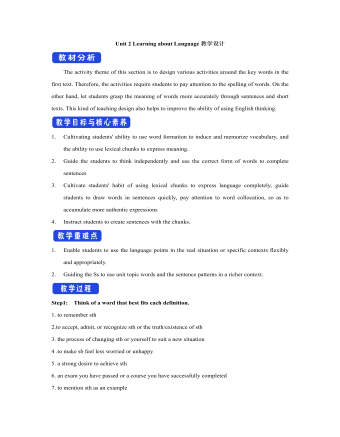
新人教版高中英语选修2Unit 2 Learning about Language教学设计
The activity theme of this section is to design various activities around the key words in the first text. Therefore, the activities require students to pay attention to the spelling of words. On the other hand, let students grasp the meaning of words more accurately through sentences and short texts. This kind of teaching design also helps to improve the ability of using English thinking.1. Cultivating students' ability to use word formation to induce and memorize vocabulary, and the ability to use lexical chunks to express meaning.2. Guide the students to think independently and use the correct form of words to complete sentences3. Cultivate students' habit of using lexical chunks to express language completely, guide students to draw words in sentences quickly, pay attention to word collocation, so as to accumulate more authentic expressions4. Instruct students to create sentences with the chunks.1. Enable students to use the language points in the real situation or specific contexts flexibly and appropriately.2. Guiding the Ss to use unit topic words and the sentence patterns in a richer context.Step1: Think of a word that best fits each definition.1. to remember sth2.to accept, admit, or recognize sth or the truth/existence of sth3. the process of changing sth or yourself to suit a new situation4 .to make sb feel less worried or unhappy5. a strong desire to achieve sth
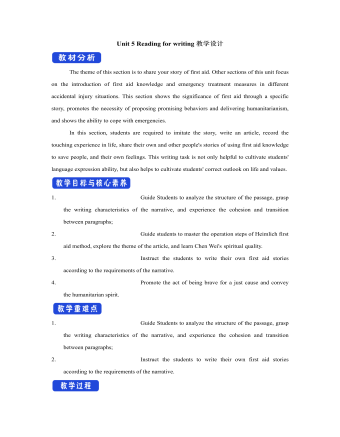
新人教版高中英语选修2Unit 5 Reading for writing教学设计
你校英语报计划出版一期急救常识专刊,现面向全校学生公开征集稿件,你有意参加。请你根据下面提示内容,用英语写一篇短文,介绍在车祸现场对伤者进行急救的方法和步骤。1.确保现场的安全;2.询问伤者,确保其呼吸正常;3.检查伤口,如流血则应采取止血措施;4.如需急救,确保其处于康复位置。注意:1.词数80左右;2.可以适当增加细节,以使行文连贯。参考词汇:康复位置 recovery positionAs we all know, having a knowledge of first aid can make a great difference in our daily life. If a traffic accident happens and someone is injured, the following steps can be used to treat the injured.In the first place, we should make sure that the accident scene is safe so that we won’t get hurt. We should ask the injured person if he is OK, and see if he is breathing. What’s more, we should check for cuts and wounds. If he is bleeding badly, it is vital that we should try to stop the bleeding by applying pressure to the injury. This is because if a person loses too much blood, he may die. If necessary, take the injured person to the hospital as soon as possible.Do remember: when giving first aid, please be sure to place the person in a recovery position.
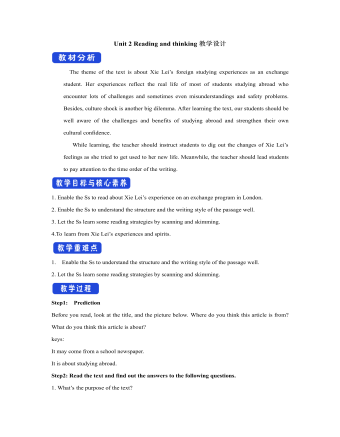
新人教版高中英语选修2Unit 2 Reading and thinking教学设计
Her tutor told her to acknowledge __________ other people had said if she cited their ideas, and advised her _______(read) lots of information in order to form __________wise opinion of her own.Now halfway __________ her exchange year, Xie Lei felt much more at home in the UK. She said __________ (engage) in British culture had helped and that she had been__________ (involve) in social activities. She also said while learning about business, she was acting as a cultural messenger __________(build) a bridge between the two countries. keys:Xie Lei, a 19yearold Chinese student, said goodbye to her family and friends in China and boarded (board) a plane for London six months ago in order to get a business qualification. She was ambitious(ambition) to set up a business after graduation. It was the first time that she had left (leave) home.At first, Xie Lei had to adapt to life in a different country. She chose to live with a host family, who can help with her adaptation (adapt) to the new culture. When she missed home, she felt comforted (comfort) to have a second family. Also Xie Lei had to satisfy academic requirements. Her tutor told her to acknowledge what other people had said if she cited their ideas, and advised her to read lots of information in order to form a wise opinion of her own.Now halfway through her exchange year, Xie Lei felt much more at home in the UK. She said engaging (engage) in British culture had helped and that she had been involved (involve) in social activities. She also said while learning about business, she was acting as a cultural messenger building a bridge between the two countries.
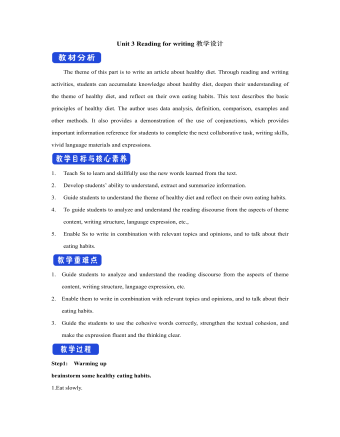
新人教版高中英语选修2Unit 3 Reading for writing教学设计
The theme of this part is to write an article about healthy diet. Through reading and writing activities, students can accumulate knowledge about healthy diet, deepen their understanding of the theme of healthy diet, and reflect on their own eating habits. This text describes the basic principles of healthy diet. The author uses data analysis, definition, comparison, examples and other methods. It also provides a demonstration of the use of conjunctions, which provides important information reference for students to complete the next collaborative task, writing skills, vivid language materials and expressions.1. Teach Ss to learn and skillfully use the new words learned from the text.2. Develop students’ ability to understand, extract and summarize information.3. Guide students to understand the theme of healthy diet and reflect on their own eating habits.4. To guide students to analyze and understand the reading discourse from the aspects of theme content, writing structure, language expression, etc., 5. Enable Ss to write in combination with relevant topics and opinions, and to talk about their eating habits.1. Guide students to analyze and understand the reading discourse from the aspects of theme content, writing structure, language expression, etc.2. Enable them to write in combination with relevant topics and opinions, and to talk about their eating habits.3. Guide the students to use the cohesive words correctly, strengthen the textual cohesion, and make the expression fluent and the thinking clear.Step1: Warming upbrainstorm some healthy eating habits.1.Eat slowly.2.Don’t eat too much fat or sugar.3.Eat healthy food.4.Have a balanced diet.Step2: Read the passage and then sum up the main idea of each paragraph.
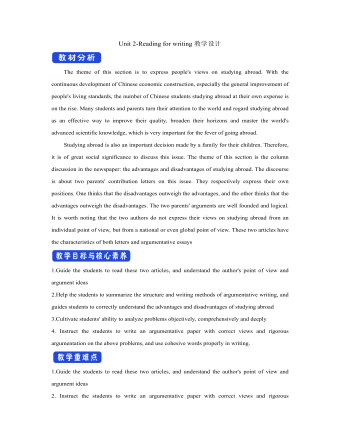
新人教版高中英语选修2Unit 2 Reading for writing教学设计
The theme of this section is to express people's views on studying abroad. With the continuous development of Chinese economic construction, especially the general improvement of people's living standards, the number of Chinese students studying abroad at their own expense is on the rise. Many students and parents turn their attention to the world and regard studying abroad as an effective way to improve their quality, broaden their horizons and master the world's advanced scientific knowledge, which is very important for the fever of going abroad. Studying abroad is also an important decision made by a family for their children. Therefore, it is of great social significance to discuss this issue. The theme of this section is the column discussion in the newspaper: the advantages and disadvantages of studying abroad. The discourse is about two parents' contribution letters on this issue. They respectively express their own positions. One thinks that the disadvantages outweigh the advantages, and the other thinks that the advantages outweigh the disadvantages. The two parents' arguments are well founded and logical. It is worth noting that the two authors do not express their views on studying abroad from an individual point of view, but from a national or even global point of view. These two articles have the characteristics of both letters and argumentative essays1.Guide the students to read these two articles, and understand the author's point of view and argument ideas2.Help the students to summarize the structure and writing methods of argumentative writing, and guides students to correctly understand the advantages and disadvantages of studying abroad3.Cultivate students' ability to analyze problems objectively, comprehensively and deeply
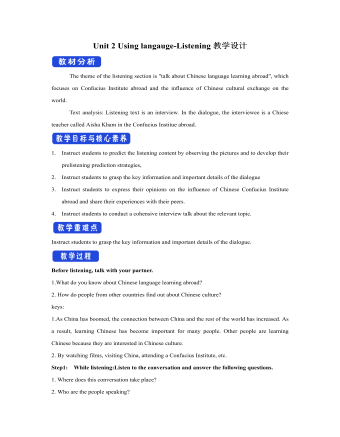
新人教版高中英语选修2Unit 2 Using langauge-Listening教学设计
? B: Absolutely! Getting involved with Chinese cultural activities there definitely helped a lot. I got to practice my Chinese on a daily basis, and I could learn how native Chinese speakers spoke.? A: What do you feel is your biggest achievement?? B: Learning Chinese characters! I have learnt about 1,500 so far. When I first started, I didn't think it was even going to be possible to learn so many, but now I find that I can read signs, menus, and even some easy newspaper articles.? A: What are you most keen on?? B: I've really become keen on learning more about the Chinese culture, in particular Chinese calligraphy. As I have learnt Chinese characters, I have developed a great appreciation for their meaning. I want to explore Chinese characters by learning how to write them in a more beautiful way. ? A: Finally, what do you want to say to anyone interested in learning Chinese?? I have really become keen on learning more about the Chinese culture, in particular Chinese Calligraphy. As I have learnt Chinese character, I have developed a great appreciation for their meaning. I want to explore Chinese characters by learning how to write them in a more beautiful way.? A: Finally, what do you want to say to anyone interested in learning Chinese?? B: I'd say, give it a shot! While some aspects may be difficult, it is quite rewarding and you will be happy that you tried.? A: Thanks for your time. ? B:You're welcome.

新人教版高中英语选修2Unit 3 Using langauge-Listening教学设计
1. How is Hunan cuisine somewhat different from Sichuan cuisine?The heat in Sichuan cuisine comes from chilies and Sichuan peppercorns. Human cuisine is often hotter and the heat comes from just chilies.2.What are the reasons why Hunan people like spicy food?Because they are a bold people. But many Chinese people think that hot food helps them overcome the effects of rainy or wet weather.3.Why do so many people love steamed fish head covered with chilies?People love it because the meat is quite tender and there are very few small bones.4.Why does Tingting recommend bridge tofu instead of dry pot duck with golden buns?Because bridge tofu has a lighter taste.5 .Why is red braised pork the most famous dish?Because Chairman Mao was from Hunan, and this was his favorite food.Step 5: Instruct students to make a short presentation to the class about your choice. Use the example and useful phrases below to help them.? In groups of three, discuss what types of restaurant you would like to take a foreign visitor to, and why. Then take turns role-playing taking your foreign guest to the restaurant you have chosen. One of you should act as the foreign guest, one as the Chinese host, and one as the waiter or waitress. You may start like this:? EXAMPLE? A: I really love spicy food, so what dish would you recommend?? B: I suggest Mapo tofu.? A: Really ? what's that?

新人教版高中英语选修2Unit 4 Learning about Language教学设计
This section guides students to pay attention to the typical context of vocabulary use, helps students accumulate vocabulary around the key vocabulary of this unit, and uses the learned words and word chunks in different contexts to deeply understand their meaning and usage, so as to achieve the purpose of review and consolidation.The teaching design activities aim to guide students to pay attention to the typical context in which the target vocabulary is used, as well as the common vocabulary used in collocation, so that students can complete the sentence with correct words. In terms of vocabulary learning strategies, this unit focuses on cultivating students' ability to pay attention to collocation of words and to use word blocks to express meaning.For vocabulary learning, it is not enough just to know the meaning of a single word, but the most important thing is to master the common collocations of words, namely word blocks.Teachers should timely guide students to summarize common vocabulary collocation, such as verb and noun collocation, verb and preposition collocation, preposition and noun collocation, and so on.1. Guide students to understand and consolidate the meaning and usage of the vocabulary in the context, 2. Guide the students to use the unit topic vocabulary in a richer context3. Let the students sort out and accumulate the accumulated vocabulary, establishes the semantic connection between the vocabulary,4. Enable students to understand and master the vocabulary more effectivelyGuiding the Ss to use unit topic words and the sentence patterns in a richer context.

新人教版高中英语选修2Unit 4 Reading for writing教学设计
假定你是英国的Jack,打算来中国旅行,请你给你的中国笔友李华写一封信,要点如下:1.你的旅行计划:北京→泰山→杭州;2.征求建议并询问他是否愿意充当你的导游。注意:1.词数80左右(开头和结尾已给出,不计入总词数);2.可以适当增加细节,以使行文连贯。参考词汇:故宫 the Forbidden City;泰山 Mount TaiDear Li Hua,I'm glad to tell you that 'm going to visit China.First,I am planning to visit Beijing,the capitalof China,where I am looking forward to enjoying the Great Wall,the Forbidden City and somebeautiful parks.Then I intend to go to visit Mount Tai in Shandong Province.I've heard that it is one ofthe most famous mountains in China and I can't wait to enjoy the amazing sunrise there.After that,I amalso going to Hangzhou.It is said that it is a beautiful modern city with breathtaking natural sights,among which the West Lake is a well- known tourist attraction.What do you think of my travel plan? Will you act as my guide? Hope to hear from you soon.

新人教版高中英语选修2Unit 4 Using langauge-Listening教学设计
The theme of the listening section is " talking about scenery and culture along a journey."The part is designed to further lead the students to understand Canadian natural geography and social environment, and integrated into the cultural contrast by mentioning the long train journey from Beijing to Moscow routes. On this basis, the part activates students related travel experience, lets the student serial dialogue, guides the student to explore further the pleasure and meaning of the long journey, and Chinese and foreign cultural comparison.The part also provides a framework for the continuation of the dialogue, which is designed to provide a framework for students to successfully complete their oral expressions, and to incorporate an important trading strategy to end the dialogue naturally.1. Help students to understand and master some common English idioms in the context, and experience the expression effect of English idioms.2. Guide the students to understand the identity of different people in the listening context, and finish the dialogue according to their own experience.3. Instruct the students to use appropriate language to express surprise and curiosity about space and place in the dialogue, and master the oral strategy of ending the dialogue naturally.1. Instruct students to grasp the key information and important details of the dialogue.2. Instruct students to conduct a similar talk on the relevant topic.

新人教版高中英语选修2Unit 5 Learning about Language教学设计
The purpose of this section of vocabulary exercises is to consolidate the key words in the first part of the reading text, let the students write the words according to the English definition, and focus on the detection of the meaning and spelling of the new words. The teaching design includes use English definition to explain words, which is conducive to improving students' interest in vocabulary learning, cultivating their sense of English language and thinking in English, and making students willing to use this method to better grasp the meaning of words, expand their vocabulary, and improve their ability of vocabulary application. Besides, the design offers more context including sentences and short passage for students to practice words flexibly.1. Guide students to understand and consolidate the meaning and usage of the vocabulary in the context, 2. Guide the students to use the unit topic vocabulary in a richer context3. Let the students sort out and accumulate the accumulated vocabulary, establishes the semantic connection between the vocabulary,4. Enable students to understand and master the vocabulary more effectivelyGuiding the Ss to use unit topic words and the sentence patterns in a richer context.Step1: Read the passage about chemical burns and fill in the blanks with the correct forms of the words in the box.

新人教版高中英语选修2Unit 5 Reading and thinking教学设计
The theme of this activity is to learn the first aid knowledge of burns. Burns is common in life, but there are some misunderstandings in manual treatment. This activity provides students with correct first aid methods, so as not to take them for granted in an emergency. This section guides students to analyze the causes of scald and help students avoid such things. From the perspective of text structure and collaborative features, the text is expository. Expository, with explanation as the main way of expression, transmits knowledge and information to readers by analyzing concepts and elaborating examples. This text arranges the information in logical order, clearly presents three parts of the content through the subtitle, accurately describes the causes, types, characteristics and first aid measures of burns, and some paragraphs use topic sentences to summarize the main idea, and the level is very clear.1. Guide students to understand the causes, types, characteristics and first aid methods of burns, through reading2. Enhance students’ ability to deal withburnss and their awareness of burns prevention3. Enable students to improve the ability to judge the types of texts accurately and to master the characteristics and writing techniques of expository texts.Guide students to understand the causes, types, characteristics and first aid methods of burns, through readingStep1: Lead in by discussing the related topic:1. What first-aid techniques do you know of ?CPR; mouth to mouth artificial respiration; the Heimlich Manoeuvre

新人教版高中英语选修2Unit 5 Using langauge-Listening教学设计
The theme of this section is to learn how to make emergency calls. Students should learn how to make emergency calls not only in China, but also in foreign countries in English, so that they can be prepared for future situations outside the home.The emergency telephone number is a vital hotline, which should be the most clear, rapid and effective communication with the acute operator.This section helps students to understand the emergency calls in some countries and the precautions for making emergency calls. Through the study of this section, students can accumulate common expressions and sentence patterns in this context. 1.Help students accumulate emergency telephone numbers in different countries and learn more about first aid2.Guide the students to understand the contents and instructions of the telephone, grasp the characteristics of the emergency telephone and the requirements of the emergency telephone.3.Guide students to understand the first aid instructions of the operators.4.Enable Ss to make simulated emergency calls with their partners in the language they have learned1. Instruct students to grasp the key information and important details of the dialogue.2. Instruct students to conduct a similar talk on the relevant topic.Step1:Look and discuss:Match the pictures below to the medical emergencies, and then discuss the questions in groups.
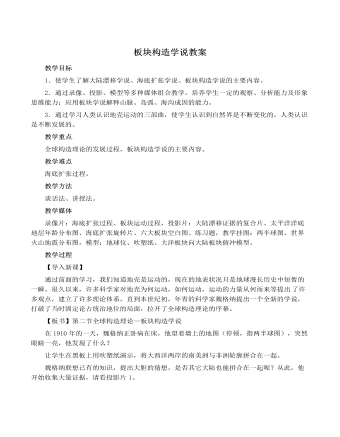
人教版高中地理选修1板块构造学说教案
【启发想象 】能否将刚才讲的内容用一个游泳动作形容一下?这好像蛙泳动作。我们大家一起做:熔岩冒出(双手合十向上)→推向两边(双手向两侧分开)→遇陆俯冲(双手往下)→重熔再生(双手相向合并向上)。【小结板书】二、海底扩张学说前面我们学习了两个假说,整理一下已知条件:事实证明大陆是在漂移的,如欧洲与美洲的距离在扩张,但是漂移的动力不足;海底是不断扩张的,有生长与消亡。能否在前人研究的基础上,提出更准确更合理的假设呢?一个新的理论诞生了,它是目前最盛行、最活跃的全球构造理论【板书】三、板块构造学说1.板块概念学生读书。【启发提问】板块“漂移”与大陆“漂移”的位置有何不同?学生回答。板块漂移是指岩石圈漂在软流层上,大陆漂移发生在地壳两层之间。【提问】板块是如何划分的?读图用半分钟记下六大板块的位置和名称(提示:按大洲和大洋名称记忆)。
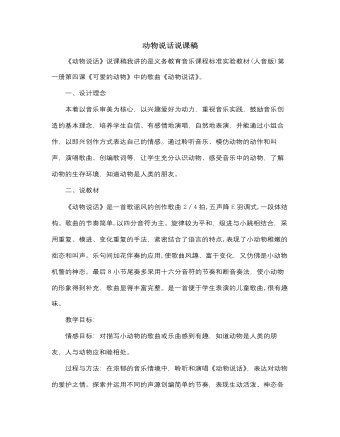
人音版小学音乐一年级上动物说话说课稿
6、总结师:听着小朋友们美妙的歌声,看着大家亲密无间的合作,老师的心里无比的快活。动物是人类的朋友,我们要保护动物,爱护动物。我想,小朋友的心情和老师心情是一样的,都很开心是吗?那么,为了表示大家高兴的心情,庆祝我们合作的愉快,我要邀请你们永远做我的朋友!(音乐起,师生一起跳舞《我们都是好朋友》)我邀请到谁,谁就可以再邀请与你合作愉快的小朋友。音乐反复到全体起立)让我们去操场邀请别的小朋友,告诉他们保护动物,爱护动物,走啦!(学生走出教室,本节教学结束)整个教学过程从一开始的律动,后来的动物模仿到创编节奏及即兴表演,运用感知法、认知法、学唱法,让学生用有感情的演唱和肢体语言表达对小动物的喜爱之情;通过创编,培养合作精神和创新能力,获得成功的喜悦。使学生的演、唱、创新、合作能力得到很好的发展,并渗透了思想教育。
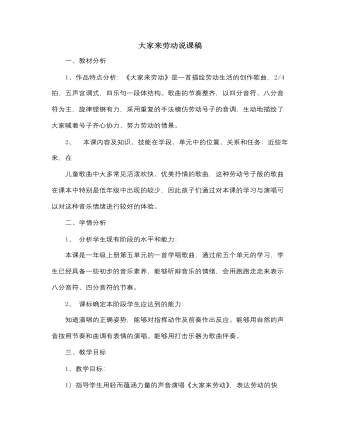
人音版小学音乐一年级上大家来劳动说课稿
2、师:"今天的音乐课上老师要带大家一起来劳动(出示课题),同学们有修桌子的叮当叮当、有擦桌子的擦擦,还有扫地的刷刷(按顺序出示节奏),让我们大家一起行动起来,加入劳动的行列。用劳动的声音来读一读,看看谁读的最准确。"(学生用劳动的声音来读的节奏实际就是歌曲的节奏,用这种方式可以让学生在潜移默化中学会歌曲中的重点节奏)[课件节奏谱]1)学生分三组按顺序读,一组读修桌子节奏,一组读擦桌子节奏,一组读扫地节奏。(这样做是为了培养学生相互配合、协作的能力)2)集体连读三、歌曲学习1、感受歌曲情绪1)师:"同学们读的很准确,反应很灵敏。看得出你们在劳动时也是非常卖力的,现在老师也想为你们这些劳动的小能手鼓劲,请你们听听老师是怎样表示的?"[课件出示前两句歌词](难点)师拿响板边拍边读:嗨哟加把劲呦,嗨哟里格嗨哟呵呵师:"刚才老师怎样为小能手加油的?"学生:嗨哟······师:你们能不能
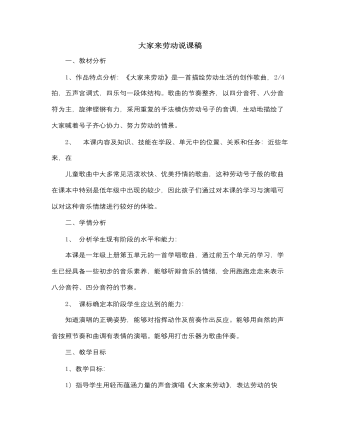
人音版小学音乐一年级上袋鼠说课稿
设计意图:幼儿听着音乐磁带边表演边唱,把自己想象是一只小袋鼠,能用自己的动作非常投入地表演起来,这种耳闻目染的熏陶,一下子就将幼儿身心带进音乐的殿堂,群情激动,气氛达到高潮。4、感受猎人打枪及狼中枪后的游戏规则:(1)音乐结束,猎人打枪,狼倒下。(2)猎人检查狼是否死了。假如有袋鼠动了,狼就立即爬起抓住袋鼠,老师问:这只袋鼠为什么被狼抓住?(猎人开枪后,还没有检查狼是不是死了,袋鼠就动了。而这只狼很狡猾,它装死,实际上它还没有死,它看见袋鼠动了,就扑过去把它捉住了)猎人随机又开枪,将大灰狼打死。老师旁白:“狼死了没有,还不知道呢?小袋鼠可千万不能动。”猎人检查完后,说“大灰狼被打死了!”老师带领小袋鼠欢呼:“大灰狼被打死了!”,听歌曲《袋鼠》高高兴兴回家。5、幼儿完整玩游戏。进一步强调游戏规则。6、结束部分:“大灰狼被打死了!” “大灰狼被打死了!”,听歌曲《袋鼠》小袋鼠跟着妈妈高高兴兴回家。
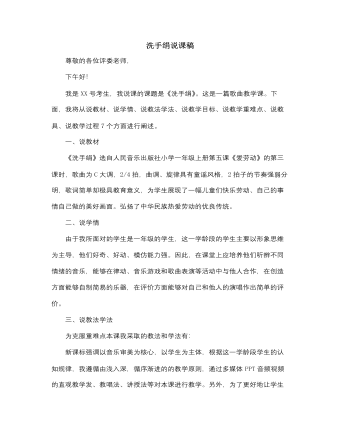
人音版小学音乐一年级上洗手绢说课稿
理论离不开实践,这个环节,为了让学生更好地体验歌曲的民谣风格,并且亲身践行自己的事情自己做和感受劳动的快乐,我将学生分成4个小组,随意解下自己的红领巾,放在讲台上事先准备的洗衣盆里清洗,并对歌词进行改编套入本曲中,边唱边洗,当唱到休止符时,要求他们做一个拧干水的动作,如:2/4 1 1 2 1 1 2 3 2 3 0: 哎 啰 哎 啰 哎 啰 哎 拧水让学生感受本曲中歌词及休止符带来的劳动感。接着,让学生对自己及他人的表现进行自评与他评,最后我来评价哪组洗的最好。让学生在做中学。最后,是我本课的教学总结本课教学,我运用了柯达伊体态律动教学法、示范法、讲授法、多媒体展示法和活动创编等方法,引导学生从多角度、多方面、多层次去体验音乐情感,通过柯达伊的律动教学,触动学生的音乐连觉反应,使其有本能的音乐反应,对学生以后形成正确的音乐学习观有着积极影响。
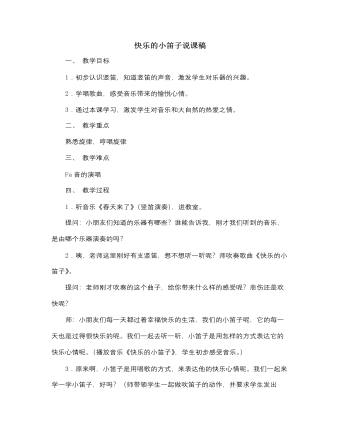
人音版小学音乐一年级上快乐的小笛子说课稿
9.恩,小朋友们唱得不错,但是,我觉得你们可以唱得更好!这样,小笛子和大鸭小鸭会玩得更开心!现在,脚放平,背坐直,带着愉快的心情,我们再来一次。10.今天最大的难题来了,小朋友们想不想挑战一下自己呢?好的,请你跟我这样唱,(教唱旋律,分两大组合作)11.同学们今天的表现实在是太棒了!比小笛子的歌声更美妙,更动听!老师希望我们每一位小朋友,都像快乐的小笛子一样,永远唱着快乐歌,快乐成长!让我们和小笛子一起,唱起来吧!(播放音乐,结束本课)。教学反思:快乐的小笛子是一年级上册第八课的一节唱歌课,歌曲非常欢快活泼,音乐里面加入了小鸭的叫声,非常具有童趣,学生都很感兴趣。但是这首歌曲速度比较快,很多学生一开始跟不上歌曲的节奏,显得手忙脚乱。所以我设计了吹笛子环节,让学生模仿小笛子的声音与动作,并进行形式的变化,如个人演奏、两人合奏,小组竞赛等形式,让学生非常感兴趣。学生很快就掌握了歌曲的难点,学生在快乐中学会了歌曲。
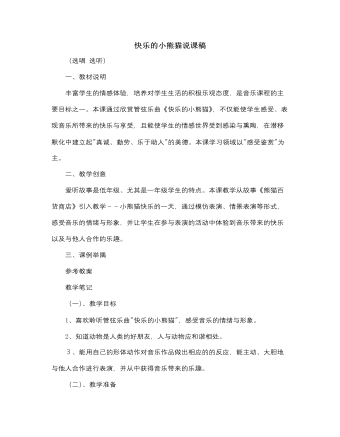
人音版小学音乐一年级上快乐的小熊猫说课稿
(时间不早了,森林里顿时热闹起来,小动物们在干什么呢?)·聆听: 听音乐第二段,感受音乐轻快的情绪。生根据自己对音乐的理解与想象回答。然后再视听结合,播放小鸟飞、在大树上叽叽喳喳的情景,进一步感受此段音乐特点,并随音乐表演。(小熊猫也出发了,看!哥弟俩抬着水桶去打水呢)。·听赏音乐第三段。感受活泼明快的"熊猫主题"。·鼓励学生模仿小熊猫打水、抬水的样子,并随音乐表演,体验音乐所表现的情绪与形象。3、完整聆听多媒体完整播放音乐及画面,学生整体感受音乐所描述的情景,同时培养学生良好的聆听音乐的习惯。4、情景表演学生选择自己喜欢的头饰,扮演动物角色,分小组随音乐进行情景表演,体验音乐带来的乐趣及与他人合作的快乐。5、评价反思、德育渗透。(四)、其他选择1、本课开始部分可用猜谜语导入。2、教师可以先让学生完整欣赏音乐,让学生根据音乐想象描述的情节,再分段欣赏。